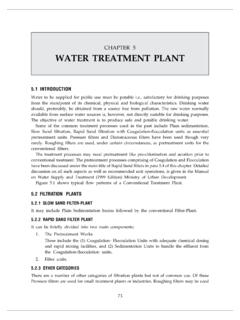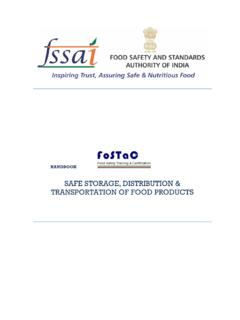Transcription of 8. Sanitation - World Health Organization
1 1038. includes solid waste disposal (including medical wastes), wastewater disposal,wastewater reuse, human excreta disposal, and drainage of surface (rain) water . Thissection deals mainly with systems for human excreta disposal, in line with the scope ofthis document. A distinction is made between systems that do not need water (dry sys-tems) and systems that need water to function (waterborne systems). The following sys-tems are described in the Fact Sheets, and they cover a wide range of technologies fordisposing of human excreta, from simple improved traditional latrines, to complex sew-erage systems: basic improved traditional latrine; ventilated improved pit latrine; double-vault compost latrine; bored hole latrine; pour-flush latrine with leaching pit; septic tank and aqua privy; vacuum tanker; manual latrine-pit emptying technology (MAPET); soakaway; drainage field; small-bore or settled and effluent treatment technologies, such as stabilization ponds and aerationponds, are not included as they are beyond the scope of this publication.
2 Bucket collec-tion of excreta also has not been included, because the collection, transportation anddisposal of excreta by this method are usually uncontrolled and unhygienic, and posehealth risks both to the collectors and to the human excreta disposal is crucial for preventing the spread of infectious dis-eases. Communities and planners need to realize that safe human excreta disposal bringsabout huge Health benefits. The control and management of wastes are an essential partof O&M. In rural areas, the users themselves are largely involved in preventive mainte-nance activities for wastewater and solid waste disposal. Awareness campaigns, and in-volving the community in Sanitation problems, can both help to change behaviour incommunities, and improve the O&M of basic Sanitation to consider when choosing a Sanitation system for excreta disposal include: the initial cost of the technology and the costs of O&M; demand and use (what is the population density, and will the system be used inhomes, schools, market places?)
3 ; climate (temperature, humidity and rainfall); soil and topography (infiltration properties of the soil, and what is the direction ofthe groundwater flow?); water availability (for waterborne systems); cultural beliefs, values and practices around Sanitation ;LINKING TECHNOLOGY CHOICE WITH OPERATION AND MAINTENANCE104 the availability of technical skills (are there local craftsmen or technicians with thenecessary skills to install and/or carry out O&M of the system?); agriculture (what are the characteristics of the local agriculture and home gar-dening). systems for excreta disposalWastewater coming from kitchens and bathrooms is termed sullage (or grey water ). Sewage (or black water ), includes sullage and human excreta from waterborne facili-ties.
4 Sewage is called sludge when it becomes a thick mud. In areas of high populationdensity, wastewater can pose a serious public- Health threat, such as when it surfaces dur-ing flooding, or when there is no proper drainage. Not only would it cause foul odours,but it would also be a source of pathogens. If sewer pipes break, or if wastewater stagnatesbecause the soil absorbs poorly, the wastewater could seep into the drinking - water supplyand contaminate problems associated with waterborne waste disposal are: the high water consump-tion; the sewer system often becomes blocked; and the high capital and O&M O&M considerations associated with four options for dealing with a full pitlatrine are shown in Table Disposal options are considered in Table Sanitation systems for excreta disposalOne dry Sanitation method is to dehydrate the human faeces.
5 Special collection devices,which divert urine into a separate container for storage, allow faeces to be dehydratedfairly easily. The urine can be used directly as a fertilizer, since urine contains most of thenutrients and the risks from pathogens are relatively low. The classic example of an eco-logical Sanitation system based on dehydration is the Vietnamese double-vault toilet. InNorthern Vietnam, a common practice was to fertilize rice fields with fresh excreta. Tocombat this hazardous practice, in 1956, the Health authorities started campaigns to con-struct double-vault dry latrines, and followed this up with Health education is now widely used in Vietnam, and to some extent in Central America, Mexico second dry Sanitation method is to compost the human faeces.
6 This involves a bio-logical process in which bacteria and worms break down the organic material undercontrolled conditions ( temperature, moisture, and airflow) and make humus. If thecomposting conditions are properly controlled, the humus is free of human pathogensand is an excellent soil conditioner. A drawback of this method is that in many develop-ing countries it is likely that the composting conditions would not be controlled prop-erly, which could lead to humus contaminated with Health aspects of dry Sanitation systems, either by dehydration or composting,are not well understood yet and these technologies cannot be recommended without aclear understanding of how they function, especially where O&M are unlikely to be ad-equate. In addition, the most unfamiliar aspect of dry Sanitation is that it requires somehandling of human faeces at household level, which for many is still taboo and mayinvolve Health risks.
7 Nevertheless, if communities wish to consider ecological sanitationtechnologies, they should be made aware of the importance of maintaining the technol-ogy in good working order, and of the consequences should the technology most common problems with dry Sanitation are: The faeces become wet (>25% humidity), and therefore smells persist, flies breed,and pathogens survive. This could be caused by leaking urine conduits or blockedvent pipes, or poor maintenance of the system. Absorbents like ash, lime, sawdust,husks, crushed dry leaves, peat moss and dry soil are used to absorb excess mois-105ture, as well as to reduce smells and make the pile less compact. Ventilation alsohelps to dry the contents, and also removes smells, allows flies to escape and, in thecase of composting toilets, provides oxygen for the decomposition process.
8 Cleaning material is used inappropriately after traditional pit technologyTraditional latrines usually consist of asingle pit covered by a slab with a drophole and a superstructure. The slab maybe made of wood (sometimes coveredwith mud) or reinforced concrete. Thesuperstructure provides shelter and pri-vacy for the user. Basic improvementsinclude: a hygienic self-draining floormade of smooth, durable materialand with raised foot rests; a tight-fitting lid that covers thedrop hole, to reduce smells andkeep insects out of the pit; a floor raised at least m aboveground level, to prevent flooding; an adequately lined pit, to preventthe pit collapsing ( when thesoil is unstable); an adequate foundation, to prevent damage of the slab and pits can be square, rectangular or circular, usually m wide.
9 The depth (usu-ally 3 5 m) depends on the soil and groundwater conditions. In unstable soil, or whenthe pit is going to be emptied, some kind of lining ( old oil drums or stones) isneeded. A foundation may be needed to support the slab and a general rule, pits should be at least 15 30 m from sources of drinking - water . Theactual distance will depend on local hydrogeological conditions, such as soil characteris-tics, and groundwater depth and flow. When groundwater levels are high, or when thesoil is too hard to dig, the pit latrine may have to be raised above ground cost: Initial costs of construction should include materials (50 80%), transporta-tion (0 25%) and local labour (15 35%). Actual costs will depend on: the pit volume;the quality of the pit lining, slab and superstructure; whether materials are availablelocally; and the local costs of materials and of use: Rural and low-income urban areas.
10 Mainly used as a household facility andfor rural O&M activitiesOperation of pit latrines is quite simple, and consists of regularly cleaning the slab withwater (and disinfectant) to remove any excreta and urine. The tight-fitting lid over thedrop hole should be replaced after use, to ensure insect control and to reduce odours. In8. SANITATIONF igure pit latrine1 Sources: Wegelin-Schuringa (1991); Franceys, Pickford & Reed (1992).LINKING TECHNOLOGY CHOICE WITH OPERATION AND MAINTENANCE106 TABLE TO DO WITH A FULL PIT LATRINE?a1. Stop using the2. Empty latrine3. Empty by simple4. Empty using alatrineby handmechanical meanstankerBack-fill the top of theDig out the contents of theUse a simple device ( a motorized tanker withlatrine with soil, and buildlatrine using a spade andMAPET) with a manpowered a vacuum If possible, pump, that is easytwin-pit latrines, which areto manoeuvre in narrowshallow and reusable.













